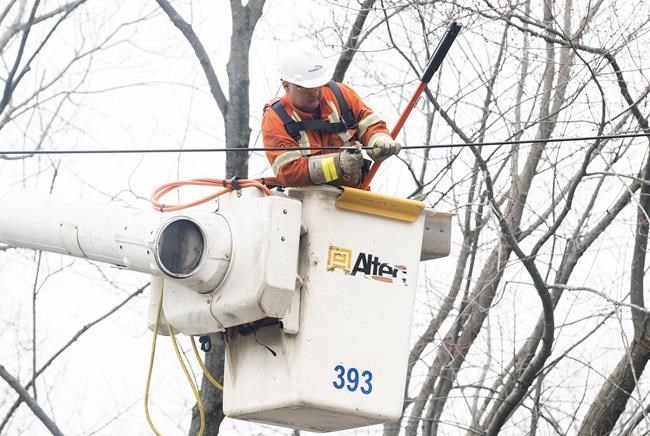MONTREAL — As some Quebecers remained in the dark Wednesday a week after an ice storm struck the province, energy experts said the lengthy outages raised questions about the resilience of the province's electrical grid.
As of Wednesday afternoon, Hydro-Québec said fewer than 1,700 customers were without power across the province, down from more than 3,000 earlier in the day. The number has been steadily dropping since the April 5 storm knocked out power to more than 1.1 million homes and businesses — almost a quarter of all customers.
François Bouffard, an electrical engineering professor at McGill University, said that as Quebec becomes increasingly reliant on electricity, the province's utility and its municipalities need to think seriously about how to strengthen the grid — and who will pay for those measures.
“Resilience, in terms of energy, is becoming a real problem that as a society we need to sit down and think about very strategically,” he said in an interview Wednesday.
Many of the longest-lasting outages occurred in suburbs in the western part of Montreal island. Bouffard said that in those areas hydro poles are often located in people’s backyards.
“It's very hard, you can't really go there with trucks, so everything has to be done manually, with linesmen going into backyards with ladders," he said. "That obviously stretches the restoration time."
As well, Hydro-Québec has a preventive maintenance backlog, but tree-pruning operations haven't kept pace with the growth of vegetation along power lines.
The issue of preventive maintenance was highlighted in a December report by Quebec's auditor general, which also found that Quebec was seeing more power outages and those outages were lasting longer.
Éloïse Edom, a research associate at the Institut de l’énergie Trottier at the Polytechnique Montréal engineering school, said the extended outages are partly a function of Quebec's geography and climate. "But it's a trend we see across North America, that electrical infrastructure is aging," she said in an interview Wednesday.
Like many other utilities, Hydro-Québec has cut back on preventive maintenance to save money, she said.
"There is a lack of resilience in the sense that these storms, they're not surprises. We don't know when they will happen, but we know that with climate change, they're going to happen more and more often, with greater severity," she said. "We have to put in place strategies to be able to react quickly and rapidly return to normal."
Hydro-Québec should reinforce lines and poles with new materials, she said, and should bury lines in dense urban areas, as well as around places like health-care facilities.
Bouffard also sees burying more lines as part of the solution, but he said there are significant costs for the energy utility, as well as for homeowners who will have to connect to those new underground lines.
“On one hand, if you do have an outage and it’s underground, the outage tends to be longer to repair, because you’ve got to dig somewhere, but on the other hand, the frequency of outages will be decreased quite substantially," he said. "Burying the distribution lines, especially in highly populated areas, would definitely be the way to go."
André Cantin, a meteorologist at Environment Canada, said the storm, which developed over Ontario, hit Quebec harder due to the geography of the St. Lawrence Valley and persistent northeast winds.
Storms like last Wednesday's are rare, he said, adding that the 20 to 30 millimetres of freezing rain that fell in the Montreal region is something typically seen once every 15 to 20 years.
Hydro spokeswoman Caroline Des Rosiers said the utility has increased its budget for tree pruning, but she said the company has to strike a balance because people who live near the power lines don't want to lose their trees.
Between 10 and 15 per cent of the utility's 120,000-kilometre network is underground, she said, though in Montreal, about 50 per cent of the lines are buried.
Montreal Mayor Valérie Plante said steps need to be taken to make the city — and its power system — more resilient and that the outages show the need for the Quebec government to provide more funding to cities to help them adapt to climate change.
"We've heard a lot of opinions about burying lines — it's a possibly, but I think we have to look at it even more broadly, and once everyone is reconnected across Quebec and, of course, in Montreal, this post-mortem, this discussion, will be all the more relevant," Plante told reporters Wednesday.
Hydro expects to reconnect all customers who lost power during the storm by the end of Wednesday, and Des Rosiers said the utility will look at what can be learned from the storm.
"We will take the time to analyze and assess how things were done, what happened and what can be done," she said. "But it's a bit too early to take away any lessons right now, since we're still in the thick of it. We believe it's the last day, but we're still in it."
This report by The Canadian Press was first published April 12, 2023.
Jacob Serebrin, The Canadian Press




